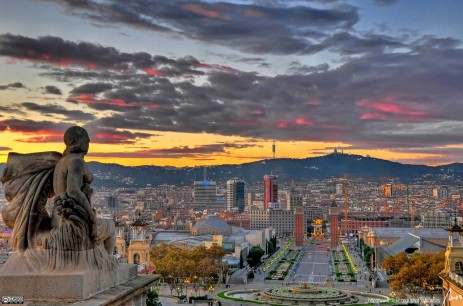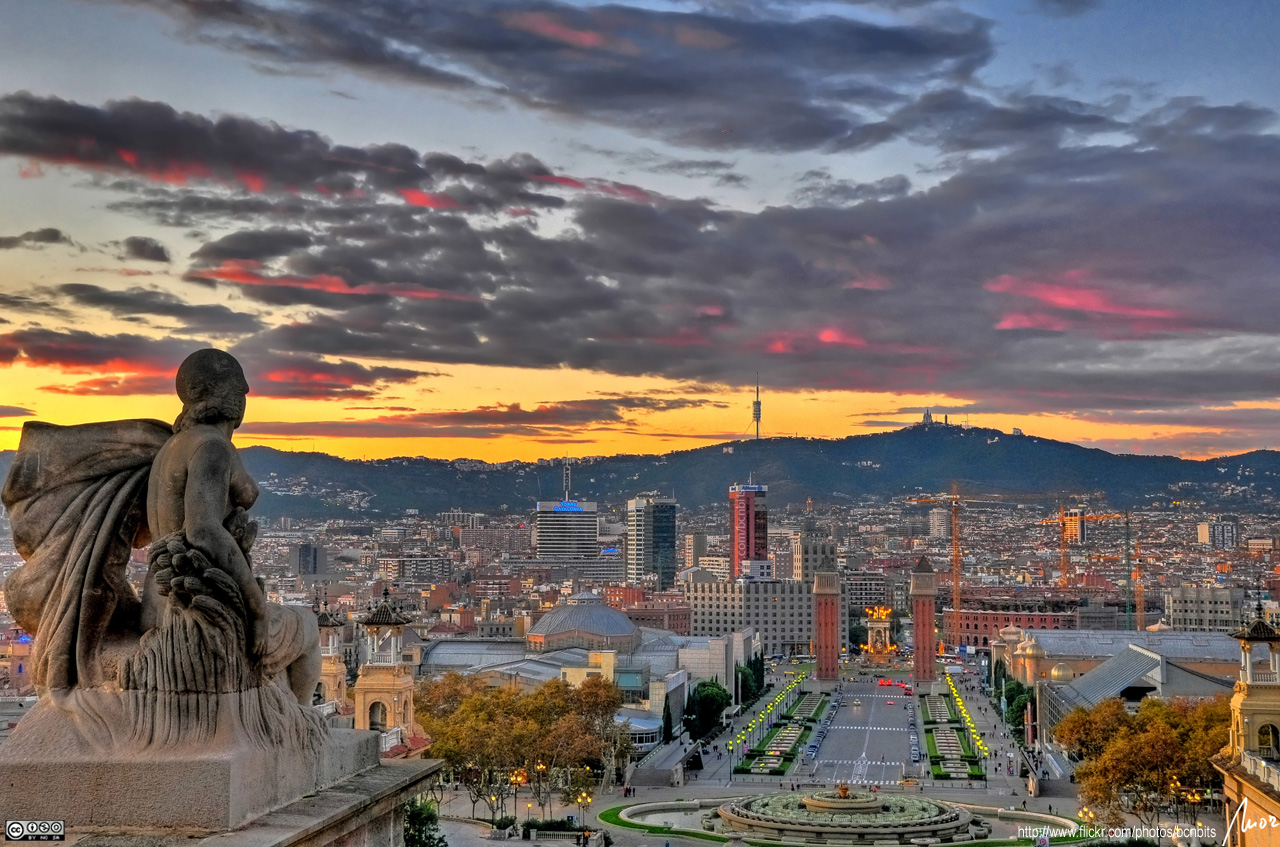 As climate talks wrapped up in Barcelona, the picture wasn’t nearly this pretty.Photo: MorBCNIt’s been 30 years since scientists gained a clear understanding of the dangerous consequences of continuously adding more carbon dioxide to the atmosphere. This week during five days of negotiations in Barcelona, the world learned again that the formula for solving global warming is a diplomatic chemistry problem that still defies a solution.
As climate talks wrapped up in Barcelona, the picture wasn’t nearly this pretty.Photo: MorBCNIt’s been 30 years since scientists gained a clear understanding of the dangerous consequences of continuously adding more carbon dioxide to the atmosphere. This week during five days of negotiations in Barcelona, the world learned again that the formula for solving global warming is a diplomatic chemistry problem that still defies a solution.
The problem is self-evident. The regulatory and financial ingredients of a successful climate treaty formula are as complex and formidable as any ever developed in human history. Plus the climate talks are buffeted by raw ideological differences, national rivalries, and even competing human emotions. Urgency and frustration marked the Barcelona talks.
At the center of this swirl of detail and conflicting sentiment is the United States, whose strategy for collaborating on a global treaty centers on a decision not to publicly announce commitments on two critical factors that the rest of the world sees as essential to reaching a final agreement. The first is how much carbon the U.S. is ready to order its industries to take out of the atmosphere. And the second is how much it will invest in developing nations to lower emissions and accelerate clean energy development.
The Obama administration has its reasons for not divulging either detail. What much of the world still doesn’t really recognize is the administration is engaged in a ferocious ideological war with Republicans over the need for climate action and the value of making the transition from fossil fuels to clean energy.
The White House also has the ghost of Kyoto sitting on its shoulder. Mindful of the Clinton administration’s inability to ratify the climate treaty that the U.S. signed in Kyoto in 1997, it doesn’t want to repeat that embarrassing chapter in American environmental and foreign policy. As president, Barack Obama has repeated pledges he made during last year’s campaign to take action on global warming. But he’s also made it clear that the administration prefers to wait for Congress to conclude its work on a new climate and energy bill before it makes specific commitments on the global treaty.
The House approved a climate and energy bill in June that proposed cutting carbon emissions 17 percent below 2005 levels by 2020, and more in the years after. It also proposed investing about $5 billion annually to help developing nations adjust to climate change.
But right in the middle of the Barcelona negotiations, the political risks of the White House strategy became clearer. Progress on a Senate bill similar to the House proposal has been beset by a focused attack from Obama’s opponents. On the second day of the Barcelona negotiations, Republican members of the Senate Environment and Public Works Committee did not show up for committee action on the bill in a move to kill it. The committee pressed forward and voted on Thursday to approve the measure, but its influence as a signal of American intentions for the Copenhagen meeting was muted. That’s because Sen. Harry Reid, the Nevada Democrat and Senate majority leader, had already agreed on Wednesday to Republican demands and approved another in a series of federal studies on the costs of the bill, a process that will take at least five weeks to complete.
In Barcelona, leaders of the climate negotiations both worried and anticipated just this sort of scenario in Washington and appealed directly to the Obama administration to take strong action separate from the congressional process. “Copenhagen has to include clarity and targets that industrialized countries, including the U.S., are willing to take in 2020 or 2030 horizon,” said Yvo de Boer, executive secretary of the United Nations Framework Convention on Climate Change, who is leading the negotiations.
He added: “I do not think the international community will accept an instrument that lacks clarity from what the U.S. will do on its emissions.”
In diplomatic terms, that is pretty strong stuff. And most other negotiators felt de Boer’s statement was justified.
According to the Intergovernmental Panel on Climate Change, the premier scientific body studying the issue, atmospheric concentrations of carbon dioxide have increased nearly 40 percent in the last century, from 278 parts million to more than 380. Average global temperatures have risen 1.5 degrees Fahrenheit. Scientists say this is the largest and fastest warming trend that they have been able to discern in the history of the Earth. And evidence of the consequences is mounting. Sea levels are rising. The Himalayan glaciers, which supply snowmelt to the headwaters of Asian rivers used by 750 million people, are melting. Severe droughts are gripping important food-growing regions, including the American Southwest and Australia’s Murray-Darling Basin. Extreme weather events — more powerful hurricanes and deadlier heat waves — are occurring.
A great deal of the carbon that floats around in the atmosphere was produced by the U.S. So in the eyes of much of the world, America has a responsibility to lead the way in preventing disaster. The United States, after all, is still the world’s largest economy and until very recently the largest carbon polluter.
For eight years under President George W. Bush, the United States dithered. Meanwhile, other nations, most importantly the European Union, took a leadership position. In Barcelona, the E.U. made it clear that it would cut carbon pollution 30 percent by 2020 if other nations make substantial commitments, and 85 percent by 2050.
The E.U. also said it would cost $150 billion annually by 2020 to help developing nations make the transition to clean energy. E.U. leaders estimated that roughly half would come from public sources, and signaled it was ready to contribute $5 billion a year immediately and maybe as much as $35 billion annually over time.
China, India, Brazil, Indonesia, and several more countries also are stepping to the front of the climate action crusade. According to Ailun Yang, a policy specialist with Greenpeace, China has promised to cut the growth of its carbon emissions by what authorities termed a “notable margin” by 2020, and which Yang said would amount to a 15 to 30 percent reduction from what emissions would have been had the country done nothing. Brazil has signaled its readiness to reduce timber cutting in the Amazon by 80 percent by 2020. Indonesia has announced a 26 percent carbon reduction by 2020.
The implication, said Yang, is that the United States can no longer hide behind the argument — as it’s done in the past — that developing nations are not bearing a share of the burden of solving climate change. “What we need to see is these efforts echoed by developed countries,” said Yang, whose rhetorical finger was pointed directly at Washington.
Even in the face of the mounting global pressure, the United States is still departing from Barcelona and headed to the Copenhagen meeting next month without divulging the two targets the world is waiting to see. But its strategy shifted.
Jonathan Pershing, the deputy special envoy for climate change and the chief American negotiator, sought in public and during private meetings with national and regional delegations to assure the world that “the U.S. is committed to an ambitious global climate change agreement in Copenhagen. Meeting the climate and clean energy challenge is a top priority in the U.S. and with President Obama.”
How will the United States achieve that objective? In the short term, by asking the world for more time and for a deeper trust. Instead of completing the treaty in December, as delegates hoped, the White House is asking the world to turn the results of the Copenhagen meeting into what President Obama this week called a “framework for progress.” Angela Merkel, the German chancellor who met with Obama in Washington on Wednesday, used almost precisely the same phrase in describing what looks to be the new goal of the Copenhagen meeting.
In effect, the U.S. is leveraging the storehouse of global good will for the new American president. In exchange for providing more time, President Obama is essentially telling the participating countries that he can deliver new climate and energy legislation in Washington early next year, and following that follow through on the strong U.S. commitments to the new climate treaty.
How much longer the world will wait for U.S. action is unclear, as is the stability of the global negotiations. The Barcelona conference closed with delegates and climate advocates vigorously debating the risks and benefits of the U.S. strategy. Meanwhile in Washington, one bipartisan group of senators said they would push to accelerate work on the climate bill, while another senator said the measure is so controversial it could be put off indefinitely.
By week’s end, the most significant result of the Barcelona meeting emerged out of this storm of uncertainty. Delegates and the nations they represent decided to continue their work and meet in Copenhagen with the conference’s leaders predicting that session will be a “turning point” that will result in a commitment by nations to a legally binding treaty, with more work to follow.
De Boer told reporters on Friday that progress was made in Barcelona on provisions of the climate treaty that focused on helping poor nations adapt to the warming planet, reducing deforestation in developing countries, and providing aid to developing nations.
But de Boer acknowledged that the talks were stymied by the U.S. position of not announcing targets for reducing carbon pollution or for financing that would allow developing countries to thrive in a new and warmer era. “Without these two pieces of the puzzle in place, we will not have a deal in Copenhagen,” said de Boer. “So leadership at the highest level is required to unlock the pieces.”
The new global bet is that Washington will indeed pass legislation next year, probably by spring, to limit carbon emissions. Then 192 participating nations will finish an effective treaty that utterly changes how the world is powered, introduces a new way for the richer and poorer nations to share financial resources, and requires levels of cooperation and trust that world leaders have never before achieved.
What we really learned this past week in Barcelona is that progress on such momentous changes is taking more time.



